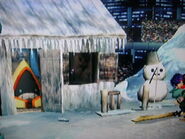No edit summary |
mNo edit summary Tag: Visual edit |
||
| (22 intermediate revisions by 17 users not shown) | |||
| Line 1: | Line 1: | ||
{{Infobox Stage |
{{Infobox Stage |
||
| − | |location = ''[[Pokémon (universe)|Pokémon]]'' |
+ | |location = ''[[Pokémon (universe)|Pokémon]]'' |
| − | |name = Pokémon Stadium 2 |
+ | |name = Pokémon Stadium 2 |
| − | |image = |
+ | |image = {{#tag:tabber| |
| + | Default Form=[[File:Stadium2.jpg|250px|Pokémon Stadium 2]] |
||
| ⚫ | |||
| + | {{!}}-{{!}}Default Form (Wii U)=[[File:Pokémon Stadium 2 (Smash Bros. for Wii U).png|thumb|250px]] |
||
| ⚫ | |||
| + | {{!}}-{{!}}Omega Form=[[File:Omega_PokeStad.png|thumb|250px]] |
||
| − | |games = ''[[Super Smash Bros. Brawl]]'' |
||
| + | {{!}}-{{!}}Default Form (Ultimate)=[[File:Pokémon Stadium 2 (SSBU).png|thumb|250px]] |
||
| − | |hometo = [[Pikachu (SSBB)|Pikachu]]<br/>[[Pokémon Trainer (SSBB)|Pokémon Trainer]]<br/>[[Jigglypuff (SSBB)|Jigglypuff]]<br/>[[Lucario (SSBB)|Lucario]] |
||
| + | {{!}}-{{!}}Omega Form (Ultimate)=[[File:PokéStadium2Omega (SSBU).png|thumb|250px]] |
||
| − | |availability = [[Starter stage|Starter]] |
||
| + | {{!}}-{{!}}Battlefield Form (Ultimate)=[[File:PokéStadium2Battlefield (SSBU).png|thumb|250px]] |
||
| − | |cratetype = Futuristic |
||
| − | |brawlsingles = Counterpick |
||
| − | |brawldoubles = Counterpick |
||
}} |
}} |
||
| ⚫ | |||
| ⚫ | |||
| + | |games = {{GameIcon|SSBB|20px}}{{GameIcon|SSB4|20px}}{{GameIcon|SSBU|20px}} |
||
| + | |hometo = '''''Brawl'''''<br/>[[Pikachu (SSBB)|Pikachu]]<br/>[[Pokémon Trainer (SSBB)|Pokémon Trainer]]<br/>[[Lucario (SSBB)|Lucario]]<br/>[[Jigglypuff (SSBB)|Jigglypuff]]<br/>'''''SSBWU'''''<br/>[[Pikachu (SSBWU/3DS)|Pikachu]]<br/>[[Charizard (SSBWU/3DS)|Charizard]]<br/>[[Lucario (SSBWU/3DS)|Lucario]]<br/>[[Jigglypuff (SSBWU/3DS)|Jigglypuff]]<br/>[[Greninja (SSBWU/3DS)|Greninja]]<br/>[[Mewtwo (SSBWU/3DS)|Mewtwo]] (DLC)<br/>'''''SSBU'''''<br/>[[Pikachu (SSBU)|Pikachu]]<br/>[[Jigglypuff (SSBU)|Jigglypuff]]<br/>[[Mewtwo (SSBU)|Mewtwo]]<br/>[[Pichu (SSBU)|Pichu]]<br/>[[Pokémon Trainer (SSBU)|Pokémon Trainer]]<br/>[[Lucario (SSBU)|Lucario]]<br/>[[Greninja (SSBU)|Greninja]]<br/>[[Incineroar (SSBU)|Incineroar]] |
||
| + | |availability = [[Starter]] (''Brawl'' and ''SSBU'')<br/>[[Unlockable]] (''SSBWU'') |
||
| + | |unlockcriteria = Clear the [[Event: When Lightning Strikes|When Lightning Strikes]] event. |
||
| + | |cratetype = Futuristic (''Brawl'')<br/>Normal (''SSBWU'' and ''SSBU'') |
||
| + | |maxplayers = 4 (''Brawl'')<br/>[[8-Player Smash|8]] (Wii U & ''Ultimate'') |
||
| + | |music = In ''Brawl'':<br/><small>''*Pokémon Main Theme''<br/>'''''*Road to Viridian City (From Pallet Town / Pewter City)'''''<br/>'''''*Pokémon Center'''''<br/>''*Pokémon Gym / Evolution''<br/>''*Wild Pokémon Battle! (Ruby / Sapphire)''<br/>'''Bolded tracks must be unlocked'''</small><br/>In ''SSBWU'':<br/><small>''*Pokémon Main Theme (Pokémon Red / Pokémon Blue)''<br/>''*Battle! (Wild Pokémon) (Pokémon Diamond / Pokémon Pearl)''<br/>''*Road to Viridian City (From Pallet Town / Pewter City)''<br/>''*Pokémon Gym/Evolution (Pokémon Red / Pokémon Blue)''<br/>''*Poké Floats''<br/>''*Pokémon Stadium''<br/>''*Pokémon Stadium 2''<br/>''*Battle! (Wild Pokémon) (Pokémon Ruby / Pokémon Sapphire)''<br/>''*Victory Road (Pokémon Ruby / Pokémon Sapphire)''</small><br/>In ''SSBU'':<br/><small>''*[[List of Music (Pokémon series)|Pokémon series music]]''<br/>''*Main: Battle! (Trainer) - Pokémon Sun / Pokémon Moon''<br/> ''*Alternate: Battle! (Gladion)''</small> |
||
| + | |brawlsingles = [[Banned stage|Banned]] |
||
| + | |brawldoubles = [[Banned stage|Banned]] |
||
| + | |ssb4singles = [[Banned stage|Banned]] |
||
| + | |ssb4doubles = [[Banned stage|Banned]] |
||
| + | |availbility=|ssbsingles=|ssbdoubles=|meleesingles=|meleedoubles=|ssbusingles=Starter/Banned|ssbudoubles=Starter/Banned}} |
||
| + | {{nihongo|'''Pokémon Stadium 2'''|ポケモンスタジアム2|Pokemon Sutajiamu 2}} is a stage in ''[[Super Smash Bros. Brawl]]'', ''[[Super Smash Bros. for Wii U]]'', and ''[[Super Smash Bros. Ultimate]]'', based on (as its name suggests) the [[Pokémon (universe)|''Pokémon'']] universe. |
||
| + | ==Stage layout== |
||
| + | [[File:Stadium2.jpg|thumb|left|Pokémon Stadium 2 in ''Brawl''.]] |
||
| + | Overall, this stage works very similarly to ''[[Super Smash Bros. Melee]]''’s [[Pokémon Stadium]]: it switches from a basic version to type-inspired transformations. The layout of the basic version is extremely similar to the ''Melee'' version, with a main platform with a solid pillar underneath and two floating soft platforms on the sides. The background features a crowd, much farther away than the one in the original Pokémon Stadium, and a screen which, like the one in Pokémon Stadium, displays either the battle, a symbol denoting the upcoming transformation, or the current standing of players and the time remaining. |
||
| + | The other transformations, however, are all completely new. Like in Pokémon Stadium, they appear in no specific order and it is even possible for the stadium to change into the same type twice in a row. However, the stage always begins on the standard arena and has to revert to its normal state before transforming again. Several Pokémon appear in the background during the various phases, with no actual effect on the battle. |
||
| − | '''Pokémon Stadium 2''' is a stage for ''[[Super Smash Bros. Brawl]]'', based in (as its name suggests) the [[Pokémon (universe)|''Pokémon'' universe]]. The basic layout of the stage is essentially unchanged from ''[[Super Smash Bros. Melee]]''<nowiki>'</nowiki>s [[Kanto: Pokémon Stadium|Pokémon Stadium]], save for a major graphical upgrade, including a huge space between the crowd and the stadium. The name of this stadium might be a reference to the game Pokémon Stadium 2 for the [[Nintendo 64]]. As with the original ''Pokémon Stadium'', every so often, the stage transforms to represent a certain Pokémon type (see "'''Elements'''" below). However, unlike its predecessor, Pokémon will occasionally appear in the background. |
||
| + | [[File:PKMNStadium2Electric.png|thumb|left|The Electric version.]] |
||
| ⚫ | |||
| + | The '''Electric type''' version features two slightly raised conveyor belts which occupy the sides of the main platform, both pushing outwards. The center of the main platform is static. There are three soft platforms in varying locations: two, one above the other, are over the middle of the stage, while the third can be over either conveyor belt. |
||
| ⚫ | |||
| ⚫ | A stage such as this has never been seen in any Pokémon game. There have been flat areas where trainers would do battle, but they were always inside buildings called 'gyms'. One reference could possibly be from the game ''Pokémon Stadium''. The arenas in Pokémon Stadium have the Poké Ball logo in the center with crowds watching the battle. Another possible origin is from the anime. There have been gyms with a theme based on a Pokémon type, such as rock or electric, and the scenery would change to match the theme. However, the exact arrangements in this stage have never been seen in a Pokémon title. A possible source of inspiration for both this stage and its [[Melee Stage]] predecessor is the Pokémon anime television show, in which type-transforming arenas featured during the Pokémon League. |
||
| + | An [[Electivire]] appears in the background on the left side, and a [[Magnezone]] pops up and down on the right side hiding behind the machinery. |
||
| ⚫ | |||
| ⚫ | |||
| ⚫ | |||
| ⚫ | The '''Flying type''' version features fans in the ground which create an updraft, severely lowering the [[gravity]]: all characters' jumping abilities are enhanced and their falling time is increased. Characters flung upward have a much higher chance of being [[Star KO]]'ed. The updraft only extends above the platform. No other platforms are present, giving the stage a [[Final Destination (SSBB)|Final Destination]] style layout. The floor is also slightly raised. |
||
| ⚫ | |||
| ⚫ | |||
| ⚫ | |||
| ⚫ | |||
| ⚫ | |||
| + | A [[Cubone]] and a [[Dugtrio]] appear in the background, along with a fossil (possibly a Helix Fossil) embedded in the rock. |
||
| ⚫ | |||
| ⚫ | |||
| ⚫ | Comparing to the background (skyscrapers), it may be [[Saffron City]] or Celadon City of Kanto, Goldenrod City of Johto, Lilycove City of Hoenn, or the Fight Area/Battle Frontier of Sinnoh. It may be a mix, if the buildings seen are from various cities/regions. Alternatively, it may be White City from the game ''Pokémon Stadium 2''. |
||
| ⚫ | |||
| + | A [[Snover]] always appears in the bakground, and a [[Snorunt]] might appear in the hut. |
||
| − | ==Songs in [[My Music]]== |
||
| − | *''Pokémon Main Theme'' |
||
| − | *'''''Road to Viridian City (From Pallet Town/Pewter City)''''' |
||
| − | *'''''The Pokémon Center''''' |
||
| − | *''Pokémon Gym/Evolution'' |
||
| − | *''Wild Pokémon Battle! (Ruby/Sapphire)'' |
||
| + | In ''[[Super Smash Bros. for Wii U]]'', during an [[8-Player Smash]] the stage always remains in its basic form and the screen in the background is blank. |
||
| − | '''Songs in bold must be unlocked''' |
||
| ⚫ | |||
| − | ==Character strengths/weaknesses== |
||
| ⚫ | |||
| − | ===Normal=== |
||
| ⚫ | A stage such as this has never been seen in any ''Pokémon'' game. There have been flat areas where trainers would do battle, but they were always inside buildings called 'gyms'. One reference could possibly be from the game ''Pokémon Stadium''. The arenas in ''Pokémon Stadium'' have the Poké Ball logo in the center with crowds watching the battle. Another possible origin is from the anime. There have been gyms with a theme based on a Pokémon type, such as rock or electric, and the scenery would change to match the theme. However, the exact arrangements in this stage have never been seen in a Pokémon title. A possible source of inspiration for both this stage and its [[Melee Stage]] predecessor is the Pokémon anime television show, in which type-transforming arenas featured during the Pokémon League. |
||
| − | ===Electric=== |
||
| − | ===Flying=== |
||
| − | ===Ground=== |
||
| − | ===Ice=== |
||
| ⚫ | |||
| − | ==Elements== |
||
| − | There are four possible stage transformations, each of which represents a particular type from the ''Pokémon'' games. While this feature was in the ''Melee'' version as well, the types represented in ''Brawl'' are all new. Whenever the stage transforms, the layout of its platforms changes, and in some cases the very physics of the game becomes altered as well. There is no specific order that these elements appear in - the stage transformation is completely random and it is even possible for the stadium to change into the same type twice in a row. However, the stage always begins on the standard arena and has to revert to its normal state before transforming again. The elements are as follows: |
||
| ⚫ | |||
| − | *'''Electric''': Has two conveyor belts near the edges on the stage, both rotating outward. The two platforms are replaced by three platforms in varying locations, either above the center of the stage, above either conveyor belt, or very high above the center of the stage. |
||
| ⚫ | |||
| ⚫ | |||
| ⚫ | |||
| ⚫ | |||
| − | ==Pokémon== |
||
| − | A new feature in Pokémon Stadium 2 is the guest Pokémon who appear in the background of altered stages. They have no effect on the battle itself, but provide a nice addition to the scenery. |
||
| ⚫ | |||
| − | *'''Electric''': [[Electivire]] and [[Magnezone]] |
||
| + | |||
| ⚫ | |||
| ⚫ | |||
| − | *'''Ground''': [[Cubone]] and [[Dugtrio]], as well as mysterious fossil. |
||
| + | |||
| − | *'''Ice''': [[Snorunt]] and [[Snover]]. |
||
| ⚫ | Comparing to the background (skyscrapers), it may be [[Saffron City]] or Celadon City of Kanto, Goldenrod City of Johto, Lilycove City of Hoenn, or the Fight Area/Battle Frontier of Sinnoh. It may be a mix, if the buildings seen are from various cities/regions. Alternatively, it may be White City from the game ''Pokémon Stadium 2''. |
||
| − | ==Easter |
+ | ==Easter egg== |
In the Stadium's Ice mode, there is a cabin in the middle of the stage. Hidden in the cabin is a poster of a kitten, and what looks like the Wii Hint Cat on the same poster. It is unknown whose kitten is pictured on the poster, but it is rumored to be [[Masahiro Sakurai|Masahiro Sakurai's]]. |
In the Stadium's Ice mode, there is a cabin in the middle of the stage. Hidden in the cabin is a poster of a kitten, and what looks like the Wii Hint Cat on the same poster. It is unknown whose kitten is pictured on the poster, but it is rumored to be [[Masahiro Sakurai|Masahiro Sakurai's]]. |
||
<gallery> |
<gallery> |
||
| Line 71: | Line 77: | ||
==Gallery== |
==Gallery== |
||
| − | <gallery> |
+ | </gallery> |
| − | File: |
+ | File:Omega_PokeStad.png|The Omega form of Pokémon Stadium 2. |
| + | Three R.O.B.s holding Rolling Crates in Super Smash Bros Wii U.jpg |
||
| ⚫ | |||
| + | Game & Watch, Three R.O.B.s, Mario, Yoshi, and Two Sonics in 8-Player Smash in Super Smash Bros Wii U.jpg |
||
| ⚫ | |||
| + | SSBU-Pokémon Stadium 2.png|Pokémon Stadium 2 in ''Super Smash Bros. Ultimate'' |
||
| ⚫ | |||
</gallery> |
</gallery> |
||
==Trivia== |
==Trivia== |
||
| − | *It is widely believed that the Flying transformation of Pokémon Stadium 2 is based on the Valley Windworks from the Sinnoh region. The inclusion of wind turbines is the main reason people think this. To further back up the theory, the rare Pokémon Drifloon makes a guest appearance here. In ''Diamond/Pearl/Platinum'', Drifloon was only obtainable by finding it in front of the Valley Windworks on Fridays. |
+ | *It is widely believed that the Flying transformation of ''Pokémon Stadium 2'' is based on the Valley Windworks from the Sinnoh region. The inclusion of wind turbines is the main reason people think this. To further back up the theory, the rare Pokémon Drifloon makes a guest appearance here. In ''Diamond/Pearl/Platinum'', Drifloon was only obtainable by finding it in front of the Valley Windworks on Fridays. |
| − | *Unlike the ''Melee'' Pokémon Stadium, characters fly in front of the screen in the background when [[Star K.O. |
+ | *Unlike the ''Melee'' Pokémon Stadium, characters fly in front of the screen in the background when [[Star KO|Star K.O.'d]]. |
| − | *In the original [[Smash Bros DOJO!!|Dojo]] screenshot of the Flying element of the stage, Drifloon and Hoppip are shown much farther away than in the final version of Brawl. |
+ | *In the original [[Smash Bros DOJO!!|Dojo]] screenshot of the Flying element of the stage, Drifloon and Hoppip are shown much farther away than in the final version of ''Brawl''. |
| − | *When playing as Wario or Wario-Man, using a fully charged [[Wario Waft]] on the Flying stage will result in an instant Star KO. |
+ | *When playing as [[Wario (SSBB)|Wario]] or [[Wario-Man]], using a fully charged [[Wario Waft]] on the Flying stage will result in an instant [[Star KO]]. |
| + | *In ''Brawl'', if playing as [[Zero Suit Samus (SSBB)|Zero Suit Samus]] the jumbotron on the background will still show the name "Samus" instead of "Zero Suit Samus", like in [[Kanto: Pokémon Stadium|Pokémon Stadium]]. |
||
| − | *When executing a Final Smash on a themed Stadium, the Pokémon disappear until the Final Smash is over. |
||
| + | *In ''Brawl'', if this stage is featured in an [[event match]] (such as in [[Event 5: Become the Champion!|Become the Champion!]]), the jumbotron in the background will not display "SUCCESS" when the player clears an event, but will display "FAILURE" when the player fails an event. This issue also happens in [[Pokémon Stadium]] and was fixed for both stages in the PAL version. |
||
| + | *In ''Ultimate'', the following [[Assist Trophy|Assist Trophies]] cannot appear on this stage: [[Andross]], [[Kapp'n]], [[Nikki]] (due to the dark background obscuring her drawings) and the [[Squid Sisters]]. Additionally, [[Marshadow]] cannot be summoned from [[Poké Ball|Poké Balls]] or [[Master Ball|Master Balls]] here. |
||
==External links== |
==External links== |
||
| Line 91: | Line 99: | ||
{{SSBBStages}} |
{{SSBBStages}} |
||
{{SSBWU Stages}} |
{{SSBWU Stages}} |
||
| + | {{SSBUStages}} |
||
{{Pokémon universe}} |
{{Pokémon universe}} |
||
[[es:Estadio Pokémon 2]] |
[[es:Estadio Pokémon 2]] |
||
[[Category:Stages]] |
[[Category:Stages]] |
||
| ⚫ | |||
[[Category:Pokémon universe]] |
[[Category:Pokémon universe]] |
||
[[Category:Starters]] |
[[Category:Starters]] |
||
[[Category:Super Smash Bros. Brawl]] |
[[Category:Super Smash Bros. Brawl]] |
||
| + | [[Category:Super Smash Bros. 3DS/Wii U]] |
||
| + | [[Category:4-8 Player Stages]] |
||
| + | [[Category:Super Smash Bros. Ultimate]] |
||
| ⚫ | |||
| + | [[Category:Stages (SSBWU/3DS)]] |
||
| + | [[Category:Stages (SSBU)]] |
||
| + | [[Category:Unlockables (SSBWU)]] |
||
| + | [[Category:Tournament-legal stages]] |
||
Latest revision as of 01:32, 2 February 2024
Pokémon Stadium 2 (ポケモンスタジアム2 Pokemon Sutajiamu 2?) is a stage in Super Smash Bros. Brawl, Super Smash Bros. for Wii U, and Super Smash Bros. Ultimate, based on (as its name suggests) the Pokémon universe.
Stage layout
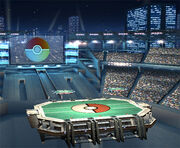
Pokémon Stadium 2 in Brawl.
Overall, this stage works very similarly to Super Smash Bros. Melee’s Pokémon Stadium: it switches from a basic version to type-inspired transformations. The layout of the basic version is extremely similar to the Melee version, with a main platform with a solid pillar underneath and two floating soft platforms on the sides. The background features a crowd, much farther away than the one in the original Pokémon Stadium, and a screen which, like the one in Pokémon Stadium, displays either the battle, a symbol denoting the upcoming transformation, or the current standing of players and the time remaining.
The other transformations, however, are all completely new. Like in Pokémon Stadium, they appear in no specific order and it is even possible for the stadium to change into the same type twice in a row. However, the stage always begins on the standard arena and has to revert to its normal state before transforming again. Several Pokémon appear in the background during the various phases, with no actual effect on the battle.
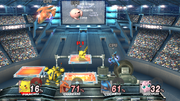
The Electric version.
The Electric type version features two slightly raised conveyor belts which occupy the sides of the main platform, both pushing outwards. The center of the main platform is static. There are three soft platforms in varying locations: two, one above the other, are over the middle of the stage, while the third can be over either conveyor belt.
An Electivire appears in the background on the left side, and a Magnezone pops up and down on the right side hiding behind the machinery.
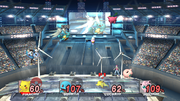
The Flying version.
The Flying type version features fans in the ground which create an updraft, severely lowering the gravity: all characters' jumping abilities are enhanced and their falling time is increased. Characters flung upward have a much higher chance of being Star KO'ed. The updraft only extends above the platform. No other platforms are present, giving the stage a Final Destination style layout. The floor is also slightly raised.
A Drifloon, a Hoppip, and a Skarmory fly about in the background.

The Ground version.
In the Ground type variation the layout changes to a large solid mound of dirt on the left and a hut built into a tall rock on the right. The hut provides two platforms, the lower one being longer and curved, and the higher one being short and flat. No physics alterations are added.
A Cubone and a Dugtrio appear in the background, along with a fossil (possibly a Helix Fossil) embedded in the rock.
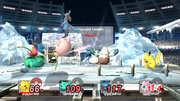
The Ice version.
In the Ice Type version all platforms and surfaces extremely slippery, so characters are more likely to trip. A hut can be seen in the background, and there are two icy platforms that slope inwards slightly.
A Snover always appears in the bakground, and a Snorunt might appear in the hut.
In Super Smash Bros. for Wii U, during an 8-Player Smash the stage always remains in its basic form and the screen in the background is blank.
Origin
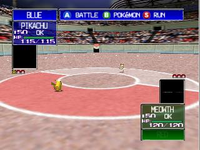
A battle in the game Pokémon Stadium. Note the Poké Ball logo in the center and the crowds of people watching the battle.
A stage such as this has never been seen in any Pokémon game. There have been flat areas where trainers would do battle, but they were always inside buildings called 'gyms'. One reference could possibly be from the game Pokémon Stadium. The arenas in Pokémon Stadium have the Poké Ball logo in the center with crowds watching the battle. Another possible origin is from the anime. There have been gyms with a theme based on a Pokémon type, such as rock or electric, and the scenery would change to match the theme. However, the exact arrangements in this stage have never been seen in a Pokémon title. A possible source of inspiration for both this stage and its Melee Stage predecessor is the Pokémon anime television show, in which type-transforming arenas featured during the Pokémon League.
It is unconfirmed as to which region exactly the stage is set in, but reasons can be found for each region in the mainstream games, excluding the then-nonexistent Unova and Kalos.
- Kanto: The original Pokémon Stadium was set in Kanto.
- Johto: The N64 game introduced the Johto region's Pokémon to 3D, and may have been set in Johto itself.
- Hoenn: The Generation Three battle theme Wild Pokémon Battle! (Ruby/Sapphire) is the only "true" battle theme to appear on the stage. The theme originates from the Hoenn region.
- Sinnoh: The stage stars a number of Sinnoh-only Pokémon. In addition to this, the Brawl stage Spear Pillar originates in Sinnoh.
Comparing to the background (skyscrapers), it may be Saffron City or Celadon City of Kanto, Goldenrod City of Johto, Lilycove City of Hoenn, or the Fight Area/Battle Frontier of Sinnoh. It may be a mix, if the buildings seen are from various cities/regions. Alternatively, it may be White City from the game Pokémon Stadium 2.
Easter egg
In the Stadium's Ice mode, there is a cabin in the middle of the stage. Hidden in the cabin is a poster of a kitten, and what looks like the Wii Hint Cat on the same poster. It is unknown whose kitten is pictured on the poster, but it is rumored to be Masahiro Sakurai's.
Gallery
</gallery> File:Omega_PokeStad.png|The Omega form of Pokémon Stadium 2. Three R.O.B.s holding Rolling Crates in Super Smash Bros Wii U.jpg Game & Watch, Three R.O.B.s, Mario, Yoshi, and Two Sonics in 8-Player Smash in Super Smash Bros Wii U.jpg SSBU-Pokémon Stadium 2.png|Pokémon Stadium 2 in Super Smash Bros. Ultimate </gallery>
Trivia
- It is widely believed that the Flying transformation of Pokémon Stadium 2 is based on the Valley Windworks from the Sinnoh region. The inclusion of wind turbines is the main reason people think this. To further back up the theory, the rare Pokémon Drifloon makes a guest appearance here. In Diamond/Pearl/Platinum, Drifloon was only obtainable by finding it in front of the Valley Windworks on Fridays.
- Unlike the Melee Pokémon Stadium, characters fly in front of the screen in the background when Star K.O.'d.
- In the original Dojo screenshot of the Flying element of the stage, Drifloon and Hoppip are shown much farther away than in the final version of Brawl.
- When playing as Wario or Wario-Man, using a fully charged Wario Waft on the Flying stage will result in an instant Star KO.
- In Brawl, if playing as Zero Suit Samus the jumbotron on the background will still show the name "Samus" instead of "Zero Suit Samus", like in Pokémon Stadium.
- In Brawl, if this stage is featured in an event match (such as in Become the Champion!), the jumbotron in the background will not display "SUCCESS" when the player clears an event, but will display "FAILURE" when the player fails an event. This issue also happens in Pokémon Stadium and was fixed for both stages in the PAL version.
- In Ultimate, the following Assist Trophies cannot appear on this stage: Andross, Kapp'n, Nikki (due to the dark background obscuring her drawings) and the Squid Sisters. Additionally, Marshadow cannot be summoned from Poké Balls or Master Balls here.
External links
| ||||||||||||||
| ||||||||||||||||||||||||
| Characters | Pikachu / Pikachu Libre (64 · Melee · Brawl · 3DS/Wii U · Ultimate) Jigglypuff (64 · Melee · Brawl · 3DS/Wii U · Ultimate) Pichu (Melee · Ultimate) Mewtwo (Melee · 3DS/Wii U · Ultimate) Pokémon Trainer (Brawl · Ultimate): Charizard (Brawl · 3DS/Wii U · Ultimate) · Squirtle (Brawl · Ultimate) · Ivysaur (Brawl · Ultimate) Lucario (Brawl · 3DS/Wii U · Ultimate) Greninja (3DS/Wii U · Ultimate) Incineroar (Ultimate) | |
|---|---|---|
| Side Characters | Boss | Rayquaza |
| Mii Fighter Costume | Team Rocket | |
| Background characters | Axew · Azelf · Blastoise · Clawitzer · Cubone · Dragonite · Drifloon · Dugtrio · Electivire · Emolga · Honedge · Hoppip · Hydreigon · Magnezone · Mesprit · Milotic · Moltres · Pidgey · Piplup · Pyroar · Scizor · Shaymin · Skarmory · Snorunt · Steelix · Uxie · Wailord · Whimsicott · Yveltal · Zapdos | |
| Stage Hazards | Chansey · Charmander · Cresselia · Dialga · Electrode · Ho-oh · Manaphy · Palkia · Porygon · Rayquaza · Registeel · Reshiram · Venusaur · Zekrom | |
| Enemies | Chandelure · Cryogonal · Gastly · Koffing · Petilil | |
| Poké Ball Pokémon | Abomasnow · Abra · Alolan Exeggutor · Arceus · Articuno · Beedrill · Bellossom · Bewear · Blastoise · Bonsly · Celebi · Chansey · Charizard · Chespin · Chikorita · Clefairy · Cyndaquil · Darkrai · Dedenne · Deoxys · Ditto · Eevee · Electrode · Entei · Fennekin · Fletchling · Gardevoir · Genesect · Giratina · Gogoat · Goldeen · Groudon · Gulpin · Hitmonlee · Ho-Oh · Inkay · Jirachi · Keldeo · Koffing · Kyogre · Kyurem · Latias and Latios · Lugia · Lunala · Manaphy · Marill · Marshadow · Meloetta · Meowth · Metagross · Mew · Mimikyu · Moltres · Munchlax · Onix · Oshawott · Palkia · Piplup · Porygon2 · Pyukumuku · Raichu · Raikou · Scizor · Snivy · Snorlax · Solgaleo · Spewpa · Starmie · Staryu · Suicune · Swirlix · Tapu Koko · Togedemaru · Togepi · Torchic · Unown · Venusaur · Victini · Vulpix · Weavile · Weezing · Wobbuffet · Xerneas · Zapdos · Zoroark | |
| Stages | Saffron City · Pokémon Stadium · Poké Floats · Pokémon Stadium 2 · Spear Pillar · Unova Pokémon League · Prism Tower · Kalos Pokémon League | |
| Items | Poké Ball · Master Ball | |
| Music | List | List of Music (Pokémon series) |
| Song | "N's Castle Medley" | |
| Collectibles | Trophies | Melee Trophies · Brawl Trophies · 3DS Trophies · Wii U Trophies |
| Stickers | List of Stickers (Pokémon series) | |
| Spirits | List of spirits (Pokémon series) | |

